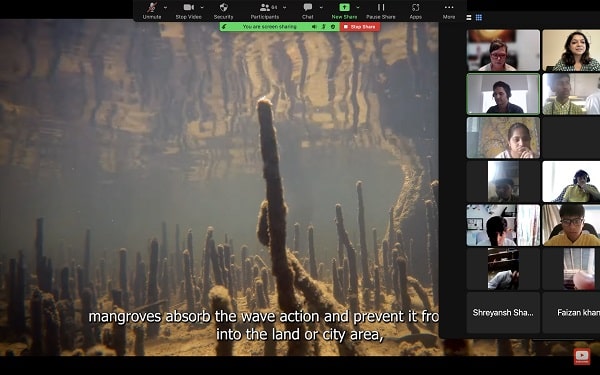The COP27 climate summit held in Egypt this month is a wake-up call for the world. The conference gave an important opportunity to table issues critical to our planet. Among several agreements forged at the event, one which stood out was the Mangrove Alliance for Climate.
Helmed by the UAE and Indonesia, the alliance has partners in India and Australia and aims to improve restoration of mangrove ecosystems.
The timing couldn’t have been more perfect – especially since both the nations recently witnessed devastating floods due to rising sea levels and eroded shorelines. A healthy mangrove ecosystem could have protected the lands. But the lack of it, could prove even deadlier in the future.
The Mangrove Life! is another effort by the two countries towards protecting mangrove forests. Designed and organised by Australia-based community driven educator Pikiji Learning, and Mumbai-based arts education company The Pomegranate Workshop, the project will integrate Australian Indigenous knowledge into classrooms in Maharashtra and Goa.

“Our experts will interact with students in classrooms and talk about mangrove use, knowledge and systems in particular parts of Australia and also make comparisons with the use of mangroves here in India,” says environmental educationist and conservationist Alex Ibarra of Pikiji Learning.
Spread over six weeks between November 12 and December 17, the program includes one in-person field trip each in Mumbai [Godrej Vikhroli Mangrove creek] and Goa [Telaulim village], where middle-school students will be encouraged to begin their scientific inquiry, interact with local fishermen and document their findings as part of their research in restoring and protecting mangrove forests.
“These findings and data stories will springboard into group projects and presentations where students create blogs/vlogs, photo essays, podcasts or short documentary films which will be showcased at the culmination of the series,” informs Advaita Mane, head of business development, The Pomegranate Workshop. “It is a seamless and continuous process of questioning, exploration, discovery, documentation and application.”

The program is also meant for science teachers who will be trained in the entire process of inquiry which involves connections with indigenous knowledge holders in the community and cultural intelligence training.
“Classroom exchanges between students in Mumbai, Goa and Australia, studying mangrove life, also provides for a powerful global exchange on environment and society,” Mane tells Indian Link.
But why is it critical for the student community to pay attention to mangroves, we ask.
“The carbon storage system, one of the intricate and important features of the mangrove systems worldwide, needs to be protected. The vast mangrove systems in India are the biggest in the world. They are of great environmental interest and value on a global scale,” explains Carlie Ring, who has run STEM programs in Bangkok, Shanghai and Hong Kong.
How exactly do mangroves protect us?
“Mangroves are thick clusters of trees or bushes that grow along the coastline,” Advaita shares. “They have very strong roots that keep away the dirt or soil of the shores from entering the seas. This in turn keeps the water clean. They are green and lush providing homes for diverse and rare species of flora and fauna which contribute to the environment and reduce air pollution. So they are literally the green lungs of coastal cities. The strong roots also help control high tides and flooding in coastal areas. If not protected, or if they are cut down, an entirely natural and fully functional ecosystem of a city goes out of balance.”

In Australia, environmental groups are quite active, and some of the political parties are also environmentally aligned, Alex tells the students. This helps in bringing issues related to climate change to light.
“In Australia, we have certain protected areas that the state and commonwealth government have put in place. The area may have limited or protected fishing in place, and boardwalks that allow exploration of mangroves while protecting them. We also have some areas that Indigenous Peoples care for and control. But all of these protect only some areas for mangroves, and not all,” he clarifies.
So Australia is a work in progress, but what about India?
“Mumbai and Goa being oceanside dwellings, the mangrove ecosystem is conjoined with urban life and livelihoods,” says Priya Srinivasan, director, The Pomegranate Workshop. “It becomes critical therefore to keep this ecosystem in focus [for the workshop] as both Mumbai and Goa pursue urbanisation and change.”

The key is to understand the many reasons impacting our coastlines.
“Removing mangroves without a plan could lead to erosion, species extinction/endangerment, impact on lifestyle and cultural obligations and responsibilities, loss of traditional knowledges and loss of culture,” concludes Carlie.
Protecting the mangrove forests could not be more vital.
READ ALSO: 70 fellowships on offer for Indian and Australian researchers




